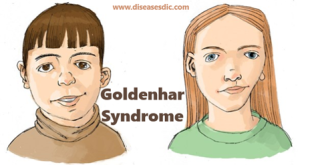Definition
Klippel-Trenaunay syndrome (KTS) is a rare congenital malformation involving blood and lymph vessels and abnormal growth of soft and bone tissue. Typical symptoms include hemangiomas (abnormal benign growths on the skin consisting of masses of blood vessels) and varicose veins. Fused toes or fingers, or extra toes or fingers, may be present. In some cases, internal bleeding may occur as a result of blood vessel malformations involving organs such as the stomach, rectum, vagina, liver, spleen, bladder, kidneys, lungs, or heart. Individuals are also at risk for blood clots. The cause of the disorder is unknown. A similar port-wine stain disorder in which individuals have vascular anomalies on the face as well as in the brain is Sturge-Weber syndrome. These individuals may experience seizures and mental deficiency. In some cases, features of the Klippel-Trenaunay syndrome and Sturge-Weber syndrome coincide. Another overlapping condition is the Parkes-Weber syndrome, which is characterized by abnormal connectivity between the arterial and venous system (arteriovenous fistulas).
Epidemiology
The estimated incidence is between 2 and 5 in 100,000 and is found equally in both sexes. Klippel-Trenaunay syndrome (KTS) is rare. Its incidence and prevalence are not known. There is no apparent ethnic or gender predilection.
Risk factors of Klippel-Trenaunay syndrome
Family history doesn’t seem to be a risk factor,
this is like that parents of one child with Klippel-Trenaunay syndrome will have another child with the disorder, even if one of the parents has KTS.
Causes of Klippel-Trenaunay syndrome
Klippel-Trenaunay syndrome can be caused by mutations in the PIK3CA gene. This gene provides instructions for making the p110 alpha (p110α) protein, which is one piece (subunit) of an enzyme called phosphatidylinositol 3-kinase (PI3K). PI3K plays a role in chemical signaling that is important for many cell activities, including cell growth and division (proliferation), movement (migration) of cells, and cell survival. These functions make PI3K important for the development of tissues throughout the body.
The PIK3CA gene mutations associated with Klippel-Trenaunay syndrome alter the p110α protein. The altered subunit makes PI3K abnormally active, which allows cells to grow and divide continuously. Increased cell proliferation leads to abnormal growth of the bones, soft tissues, and blood vessels.
Klippel-Trenaunay syndrome is one of several overgrowth syndromes, including megalencephaly-capillary malformation syndrome, that are caused by mutations in the PIK3CA gene. Together, these conditions are known as the PIK3CA-related overgrowth spectrum (PROS).
Because not everyone with Klippel-Trenaunay syndrome has a mutation in the PIK3CA gene, it is possible that mutations in unidentified genes may also cause this condition.
Symptoms
Symptoms are different for every patient, but KTS often has these characteristics:
- Swollen or malformed veins, or other problems with blood vessels
- A port wine stain (red birthmark) covering one or both legs or arms
- One arm or leg that is larger than the other from abnormal bone or tissue growth, or changes in size with internal organs or the head
- Abnormalities of the lymphatic system, with fluid buildup or swelling or development of cysts
A port wine stain in leg
Your child may also experience:
- Skin sores or ulcers that may get infected
- Bleeding from the affected limb
- Blood in the urine
- Rectal or vaginal bleeding
- Pain in the limb
- Blood clots
- Anemia
- Seizures
Complications
The possible complications of Klippel-Trénaunay syndrome include:
- DVT due to malformations of deep veins
- Pulmonary embolism
- Cellulitis
- Lymphoedema
- Internal bleeding
Klippel-Trenaunay syndrome diagnosis
The diagnosis involves a complete physical examination along with certain questions to the patient regarding familial and medical history. The diagnostic studies used are:
Duplex scanning: High-frequency sound waves are used to create detailed images of blood vessels.
Scanogram: It is an X-ray technique which takes scanned images of bones. It helps to measure the length of the bones.
Magnetic resonance angiography: Magnetic resonance angiography is used to differentiate between bone, fat, muscle and blood vessels.
CT scan: It is used to create 3 dimensional images of whole body, which helps to observe blood clots in veins.
Contrast venography: In this procedure, a dye is injected into the veins to take X-ray images which help in visualizing abnormal veins, blockages or blood clots.
Treatment and medications
Although there’s no cure for Klippel-Trenaunay syndrome, your doctor can help you manage symptoms and prevent complications.
Because KTS may affect many systems in the body, your health care team may include specialists in vascular medicine and surgery, skin diseases (dermatology), interventional radiology, orthopedic surgery, physical therapy and rehabilitation, and other areas as needed.
You and your doctor can work together to determine which of the following treatments are most appropriate for you. Treatments may include:
Compression therapy: Bandages or elastic garments are wrapped around affected limbs to help prevent swelling, problems with varicose veins and skin ulcers. These bandages or elastic garments often need to be custom-fit. Intermittent pneumatic compression devices leg or arm sleeves that automatically inflate and deflate at set intervals may be used.
Physical therapy: Massage, compression and limb movement as appropriate may help relieve lymphedema in arms or legs and swelling of the blood vessels.
Orthopedic devices: These may include orthopedic shoes or shoe inserts to compensate for differences in leg length.
Epiphysiodesis: This is an orthopedic surgical procedure that effectively can stop length overgrowth of the lower limb.
Embolization: This procedure, performed through small catheters placed into the veins or arteries, blocks blood flow to certain blood vessels.
Laser therapy: This procedure may be used to lighten port-wine stains and to treat early blebs on the skin.
Laser or radiofrequency ablation of veins: This minimally invasive procedure is used to close off abnormal veins.
Sclerotherapy: A solution is injected into a vein, which creates scar tissue that helps close the vein.
Surgery: In some cases, surgical removal or reconstruction of affected veins, removal of excess tissue, and correction of the overgrowth of bone may be beneficial.
Medication: Early research indicates that a drug called sirolimus (Rapamune) may help to treat symptomatic complex vascular malformations, but it may have significant side effects and more studies are needed.
In addition, treatment may be needed for complications such as bleeding, pain, infection, blood clots or skin ulcers.
Home remedies and lifestyle changes
Strategies to help manage Klippel-Trenaunay syndrome symptoms include:
Keep appointments: Regularly scheduled appointments can help your doctor identify and address problems early. Ask your doctor about a schedule of appointments appropriate for you.
Use orthopedic shoes, if recommended: Orthopedic shoes or shoe inserts may improve your physical function.
Follow your doctor’s recommendations on physical activity: Encouraging use of affected limbs as appropriate may help relieve lymphedema and swelling of the blood vessels.
Elevate affected limbs: When possible, raising your leg or other affected limb can help reduce lymphedema.
Notify your doctor of changes: Work with your doctor to manage your symptoms and prevent complications. Contact your doctor if you have symptoms of blood clots or an infection or if you experience increased pain or swelling.
 Diseases Treatments Dictionary This is complete solution to read all diseases treatments Which covers Prevention, Causes, Symptoms, Medical Terms, Drugs, Prescription, Natural Remedies with cures and Treatments. Most of the common diseases were listed in names, split with categories.
Diseases Treatments Dictionary This is complete solution to read all diseases treatments Which covers Prevention, Causes, Symptoms, Medical Terms, Drugs, Prescription, Natural Remedies with cures and Treatments. Most of the common diseases were listed in names, split with categories.







